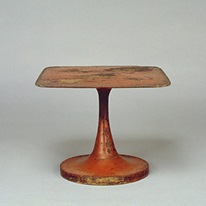Past Exhibitions
- Negoro Ware and Kamakura-bori
- June 14, 2016 - July 24, 2016
Negoro is an early type of red lacquerware originally produced in the vicinity of a temple called Negoro-ji in Wakayama. Such wares continued to be called “Negoro” even after production at the temple ended. Red lacquer was originally used to coat special wares used for celebrations or rituals. Red was used for many of the lacquers used in Buddhist or Shinto offerings, but it was less common for daily tablewares. Negoro implements have long been prized by practitioners of chanoyu, the Way of Tea. They have a dignified sense of age and patina from the black underlayers of lacquer showing through worn areas of the red surface on the simple forms. Their elegant shapes also fit well into contemporary architectural spaces, making them popular among collectors today as well.
Kamakura-bori (“Kamakura carving”) is made by carving patterns into a wood vessels and coating their surfaces with lacquer. These were also sought after by tea people. The technique dates back to the end of the Kamakura period, in the early 1300s, when Chinese culture was introduced into Japan by Zen priests. Kamakura-bori originated as a Japanese means of imitating the Chinese carved lacquers used as implements in Zen temples.












